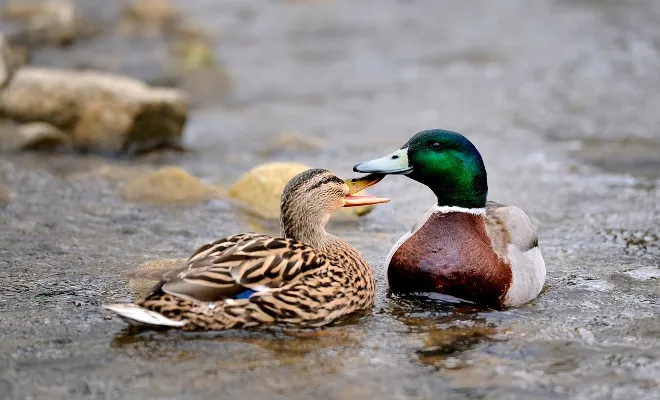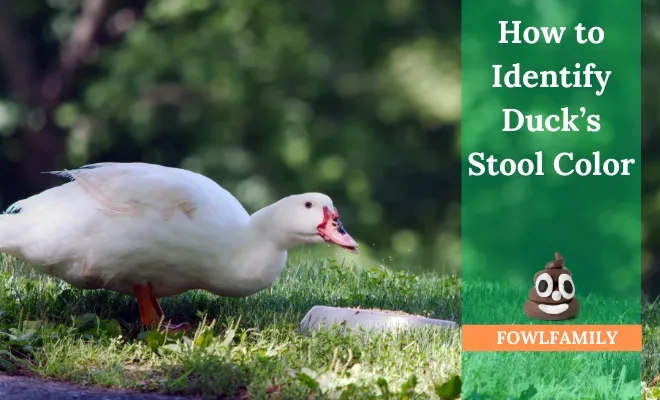White Patches On Ducks: Genetics, Health, And Environmental Factors

What are the reasons for white patches on ducks? Ducks have distinct and diverse appearances, including striking white patches on some species. These patches appear on both male and female ducks and pique the curiosity of bird enthusiasts. The presence of these white patches results from factors such as genetics, health, and environment.
Our exploration will cover genetics, molting, health indicators, nutrition, sun exposure, and parasites that are related to white patches. And we will have a richer understanding of these wetlands and pond dwellers.
Table of Contents
6 Factors of White Patches on Ducks

When observing ducks in their natural habitats or urban ponds, it’s not uncommon to notice variations in their plumage. Among these differences, one striking feature is the presence of white patches or white spotting on certain duck species.
These white patches can appear on the heads and bodies of both male and female ducks when they grow older. However, their presence can be attributed to various factors.
Let’s discuss all the factors:
1. Genetics

One of the primary reasons for the presence of white patches in ducks is genetics. These patches can be inherited traits and are often more common in certain species. The variability in white patches across different duck species is a testament to the fascinating genetic diversity within waterfowl. Here are some examples –
- Mallard (Anas platyrhynchos): Male Mallards have a shiny green head, a white ring around their neck, and a white ring on their tail. Females are more brown with an orange bill.
- Blue-winged Teal (Spatula discors): Male Blue-winged Teals have a cool white shape on their face, just behind their eyes. They also have neat blue patches on their wings.
- American Wigeon (Mareca Americana): Male American Wigeons have a special white patch on their forehead, from their eyes to their crown. They also have a green stripe by their eyes.
- Bufflehead (Bucephala albeola): Male Buffleheads have a big, round white patch on the back of their head, like a puff. Females have a smaller white patch on their cheeks.
- Wood Duck (Aix sponsa): Male Wood Ducks have bright colors and white stripes on their face. Females have a tear-shaped white ring around their eyes.
- Hooded Merganser (Lophodytes cucullatus): Male Hooded Mergansers have a cool white fan shape on their head. Females have a brown crest without the white.
- Long-tailed Duck (Clangula hyemalis): Both male and female Long-tailed Ducks have special white patches on their faces. Males also have long tail feathers.
- Common Eider (Somateria mollissima): Male Common Eiders look cool with a black and white body and a light green neck. Females are brown and spotted.
- Muscovy Duck (Cairina moschata): Muscovy Ducks can look different, but some might have white patches on their face or wings.
- King Eider (Somateria spectabilis): Male King Eiders have a colorful head with a white patch on their neck. Females are brown and spotted.
- Steller’s Eider (Polysticta stelleri): Male Steller’s Eiders have a white patch on their forehead. Both boys and girls have a special white patch on their wings.
- Spectacled Eider (Somateria fischeri): Male Spectacled Eiders look amazing with a white “spectacle” pattern around their eyes. Females are brown and spotted.
See the video! Here you can see some wild muscovies to see their patches:
2. Healthy Molting

Ducks molting is a natural process that ducks go through to replace their old feathers with new ones. During this period, some ducks may exhibit white patches on their heads and bodies.
This is not a cause for concern, as it is a normal part of the molting process. These white patches are simply areas where the old feathers have fallen out, and new ones are beginning to grow.
3. Health Issues

Molting and genetics account for many cases of white patches on ducks. However, it is necessary to be aware that they can also be indicative of underlying health problems.
Ducks that are experiencing illness or nutritional deficiencies because their feathers lose their natural pigmentation. These patches can be a sign that something is amiss and should prompt closer observation and, if necessary, medical attention.
Recommended Readings:
- Why Is My Duck Beak Pale
- Reasons My Duck Losing Feathers
- Angel Wings in Ducks
- How to Treat Water Belly In Ducks
4. Poor Nutrition

Duck plumage is affected by the quality of their diet. Ducks that do not receive a well-rounded, nutritious diet may develop white patches on their feathers. This is often due to a lack of essential vitamins and minerals necessary for healthy feather growth. Ducks that rely on human-provided food, such as bread, may be at particular risk of nutritional deficiencies leading to white patches.
5. Excessive Sun Exposure

Just as excessive sun exposure can cause harm to human skin, it can affect duck feathers as well. Prolonged exposure to harsh sunlight can bleach and damage feathers, leading to the development of white patches. Ducks that spend a lot of time in open areas with limited shade may be more susceptible to this phenomenon.
6. Parasites

Duck parasites like feather mites, can infest ducks and lead to feather damage. Ducks may pluck their feathers in response to the discomfort caused by these parasites, resulting in white patches. Proper sanitation and regular check-ups can help prevent and treat such infestations.
What Can You Do To Treat White Patches on Ducks? 3 Tips To Follow
Some tips if you find unusual white patches on your ducks:
- To help calm the skin and encourage the growth of new feathers, apply a topical treatment to the affected areas.
- Give your duck a supplement containing vitamins and minerals to help strengthen their immune system and improve feather quality.
- Lessen the tension in your duck’s surroundings. Give them lots of places to hide and opportunities to exercise.
Recommended Read: Diseases In Ducks
Bottom Line
White patches on ducks plumage are a captivating and diverse phenomenon stemming from a range of factors. Genetics plays a pivotal role, with specific species displaying unique patterns. Healthy molting is a natural process that can also lead to temporary white patches.
However, these patches can be a cause for concern when indicative of underlying health issues or poor nutrition. This is because they may signal feather pigmentation loss. Additionally, excessive sun exposure and parasitic infestations are factors to consider.
Resources & References:
- https://www.ducks.ca/species/
- https://www.birds.cornell.edu/crows/domducks.htm






